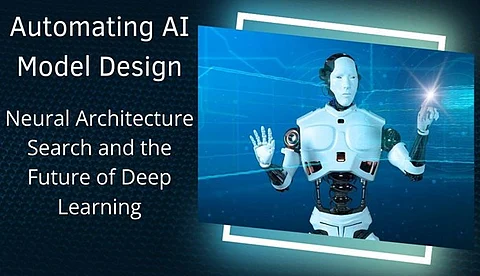

Neural Architecture Search (NAS) is revolutionizing AI by automating the complex design of neural networks, a task traditionally reserved for experts. Sunny Guntuka, a leading NAS researcher, examines how this breakthrough accelerates model development across fields like image recognition, NLP, and mobile computing. His insights highlight NAS’s potential to enhance performance and democratize AI model design.
NAS transforms AI development by enabling machines to design machine learning models, embracing a meta-learning approach or “learning to learn.” Unlike traditional expert-driven methods, NAS explores an expansive search space of network configurations, optimizing for specific tasks and uncovering designs that humans might miss, accelerating AI research.
A NAS system comprises three core components for discovering optimal architectures:
Search Space: Defines potential architectures, including layer types and configurations, enabling exploration that balances complexity with performance.
Search Strategy: Applies techniques like reinforcement learning, evolutionary algorithms, and gradient-based methods to efficiently navigate the search space for top-performing architectures.
Performance Estimation: Ensures quick, accurate evaluations, crucial for reducing computational costs—a significant challenge in NAS applications.
NAS has a wide-ranging impact on AI applications, providing optimized architectures for various needs:
Image Classification: NAS-designed models, such as EfficientNet, outperform traditional models in both accuracy and efficiency on benchmarks like ImageNet. Optimized for accuracy and computational cost, NAS models are ideal for large-scale classification tasks.
Natural Language Processing (NLP): NAS has generated architectures that excel in machine translation, sentiment analysis, and language modeling, achieving comparable performance to manually crafted models and showcasing NAS’s versatility across different neural network types.
Object Detection: NAS has advanced real-time object detection by creating architectures that emphasize both accuracy and efficiency, benefiting applications like autonomous vehicles and robotics that require rapid object recognition.
Mobile and Edge Computing: NAS optimizes models like MobileNetV3 to balance accuracy with latency for devices with limited resources, tailoring architectures to specific hardware constraints for effective on-device AI.
NAS employs several techniques to discover optimal architectures:
Reinforcement Learning (RL): Frames architecture search as a sequential decision-making task. An agent proposes architectures and learns from performance rewards, iteratively improving designs.
Evolutionary Algorithms: Inspired by natural selection, these algorithms maintain a population of architectures, selecting top performers and creating variations over generations.
Gradient-Based Methods: By treating search as a differentiable optimization, gradient-based methods streamline the process, making it faster and more efficient.
Each method has unique strengths, and combining them often maximizes exploration and efficiency.
NAS faces the challenge of high computational costs in evaluating thousands of architectures, often demanding extensive GPU resources. Researchers are mitigating this with techniques like weight sharing, progressive search strategies, and prediction-based performance estimation, reducing resource demands and improving accessibility for smaller teams.
While NAS has clear advantages, it faces key challenges:
Search Space Design: Defining an effective search space is crucial. It must be broad enough to include top-performing architectures yet manageable for efficient exploration.
Transferability: Ensuring NAS architectures generalize across tasks is difficult. Researchers are developing multi-task learning and better evaluation metrics to improve adaptability.
Interpretability: NAS often generates complex architectures, limiting insights into why specific designs perform well. This has increased interest in making NAS models more interpretable, enhancing broader adoption and trust.
As NAS advances, promising research directions could amplify its AI impact:
Efficient Search Algorithms: Refining algorithms to reduce computation will make NAS more practical across applications, broadening accessibility.
Multi-Objective Optimization: Balancing metrics like accuracy, latency, and energy use will create architectures fit for real-world deployment.
Cross-Task Adaptation: Applying NAS to diverse architectures, including graph neural networks and transformers, enables new multi-modal learning opportunities.
In conclusion, Sunny Guntuka highlights Neural Architecture Search as a major leap in AI, automating model design and expanding access to advanced AI capabilities. While challenges like computational cost and generalization persist, ongoing research in efficient algorithms and optimization is tackling these issues. With integration into hardware-aware design and diverse applications, NAS stands poised to shape AI's future, streamlining development and unlocking greater potential.
